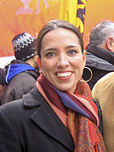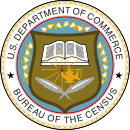- Costa Rican American
-
Costa Rican American Franklin Chang-Diaz · Sonia Chang-Diaz Total population Costa Rican
108,164 Americans
up to roughly 0.04% of the US populationLanguages Religion Predominantly Roman Catholic, minority Protestant
A Costa Rican American is an inhabitant of the United States who is of Costa Rican descent or birth.
The American Community Survey estimated the population of Costa Rican Americans to be 117,563 in 2007.[1]
Contents
History
In fact, have never been waves of migration from Costa Rica to the United States and the Immigration and Naturalization Service records indicate that very few Costa Ricans have tried to enter the country so illegally. This is because, unlike other Hispanic groups, they have not been forced to emigrate to the U.S. for political oppression or extreme economic circumstances. Most costarriquenses living in the United States have been established here for any of the following reasons: They Have Americans married people, raised by wicho Their Families in the United States, They Have Been Hired to work in the United States After Completing a degree in an American university, They Have eaten research seeking Opportunities Which are not so readily available in Their Country, Or they have come to various jobs and trades in the United States.
Since 1931 only 57,661 Costa Ricans have immigrated to the United States. Hence, the number of Costa Rican emigrants has been increasing very slowly. This is very different from the pattern of emigration from most other Central American countries. In fact, the other two countries in this region that have a continuously slow rate of emigration are Belize and Panama. [2]
Demography
The most of Costa Ricans that live in United States live in California, Florida, Texas, and the New York City / New Jersey area. The areas with the largest Costa Rican populations, in according to the latter reports, are: Los Angeles and its surrounding areas (23,625), New York City area (including parts of Connecticut, New Jersey, and Long Island (12,985)), Miami and surrounding areas (in the Hialeah) and in Fort Lauderdale) (9,987) and in the Houston and Galveston area of Texas (2,534). There is also a significant Costa Rican American population in the Chicago, Illinois, and Gary, Indiana, areas (1,845). The geographical preferences of Costa Ricans se hacen evident in the statistics from the Immigration and Naturalization Service, as consistent with the findings of the 1990 census.
Costa Ricans tend to disappear in the English-speaking population or form working and friendly relationships with other Hispanics, celebrating with them when the occasion arises. The most of Costa Rican Americans maintain their heritage, but they also tend to integrate and adjust to their environment quickly, especially if they want to join a church or if they have children in the public school system. If both parents speak Spanish, chances are that the children will be raised bilingually. However, if only one parent speaks Spanish, the children will usually grow up speaking only English. Since Costa Ricans did not suffer ethnic persecution during the colonial period, nor did they have a violent war of independence, they are not as self-conscious about their ethnicity as other Hispanic groups. Therefore, they usually acculturate and assimilate rather rapidly. [2]
Communities
The following is a list of the top 25 U.S. communities, of 500 or more people, with the highest percentages of people born in Costa Rica:[3]
- Bound Brook, New Jersey 14.7%
- Lincolnton, North Carolina 8.8%
- Irwindale, California 5.2%
- Somerville, New Jersey 5.0%
- Boger City, North Carolina 3.5%
- Raritan, New Jersey 3.3%
- Summit, New Jersey 3.2%
- Springs, New York 3.1%
- Dover, New Jersey 1.9%
- Utopia, Florida 1.8%
- Hampton Bays, New York 1.8%
- Maiden, North Carolina 1.7%
- Sans Souci, South Carolina 1.7%
- Manville, New Jersey 1.6%
- Ashland City, Tennessee 1.6%
- Wendover, Utah 1.6%
- South Bound Brook, New Jersey 1.5%
- Arroyo Colorado Estates, Texas 1.5%
- Belvedere, South Carolina 1.4%
- Lake Clarke Shores, Florida 1.4%
- Clinton, New Jersey 1.4%
- Biscayne Park, Florida 1.4%
- Bridgehampton, New York 1.4%
- Sun Valley, Idaho 1.3%
- Wainscott, New York 1.3%
Notable Costa Rican Americans
- JP Calderon - model
- Ringo Cantillo
- Franklin Chang-Diaz - NASA astronaut
- Sonia Chang-Díaz - Politician
- Eliot A. Jardines
- Candice Michelle
- Rosa Mendes
- Alexander Salazar
- Harry Shum, Jr.
References
- ^ "United States - Selected Population Profile in the United States (Costa Rican)". 2007 American Community Survey. U.S. Census Bureau. http://factfinder.census.gov/servlet/IPTable?_bm=y&-qr_name=ACS_2007_1YR_G00_S0201&-qr_name=ACS_2007_1YR_G00_S0201PR&-qr_name=ACS_2007_1YR_G00_S0201T&-qr_name=ACS_2007_1YR_G00_S0201TPR&-geo_id=01000US&-reg=ACS_2007_1YR_G00_S0201:407;ACS_2007_1YR_G00_S0201PR:407;ACS_2007_1YR_G00_S0201T:407;ACS_2007_1YR_G00_S0201TPR:407&-ds_name=ACS_2007_1YR_G00_&-_lang=en&-format=. Retrieved 2008-12-08.
- ^ a b http://www.everyculture.com/multi/Bu-Dr/Costa-Rican-Americans.html Every culture of World. by Cida S. Chase. Retrieved the November 14, 2011, at 22:31 pm.
- ^ "Top 101 cities with the most residents born in Costa Rica (population 500+)". city-data.com. http://www.city-data.com/top2/h143.html. Retrieved 2008-07-31.
Hispanic and Latino American groups Central American / Caribbean Costa Rican · Cuban · Dominican · Guatemalan · Honduran · Nicaraguan · Panamanian · Puerto Rican · SalvadoranNorth American South American Argentine · Bolivian · Colombian · Chilean · Ecuadorian · Paraguayan · Peruvian · Uruguayan · VenezuelanWestern European Racial groups External links
- Costa Rican Americans - Overview, History, Modern era, Costa ricans in the united states, Settlement everyculture.com
Categories:- American people of Costa Rican descent
- Ethnic groups in the United States
- United States stubs
- Ethnic group stubs
- Costa Rica stubs
Wikimedia Foundation. 2010.



